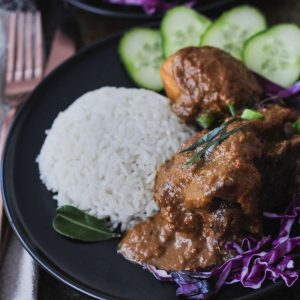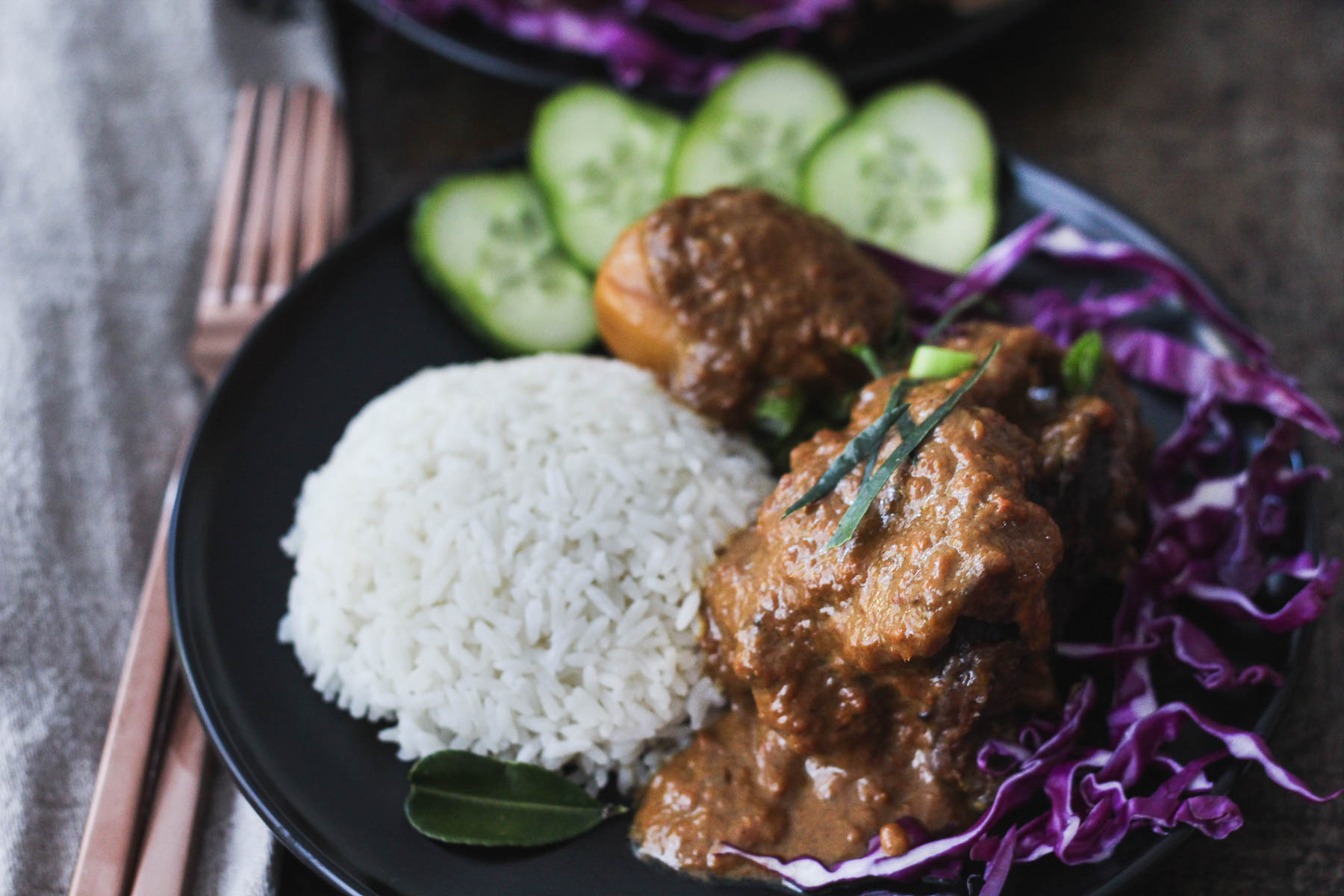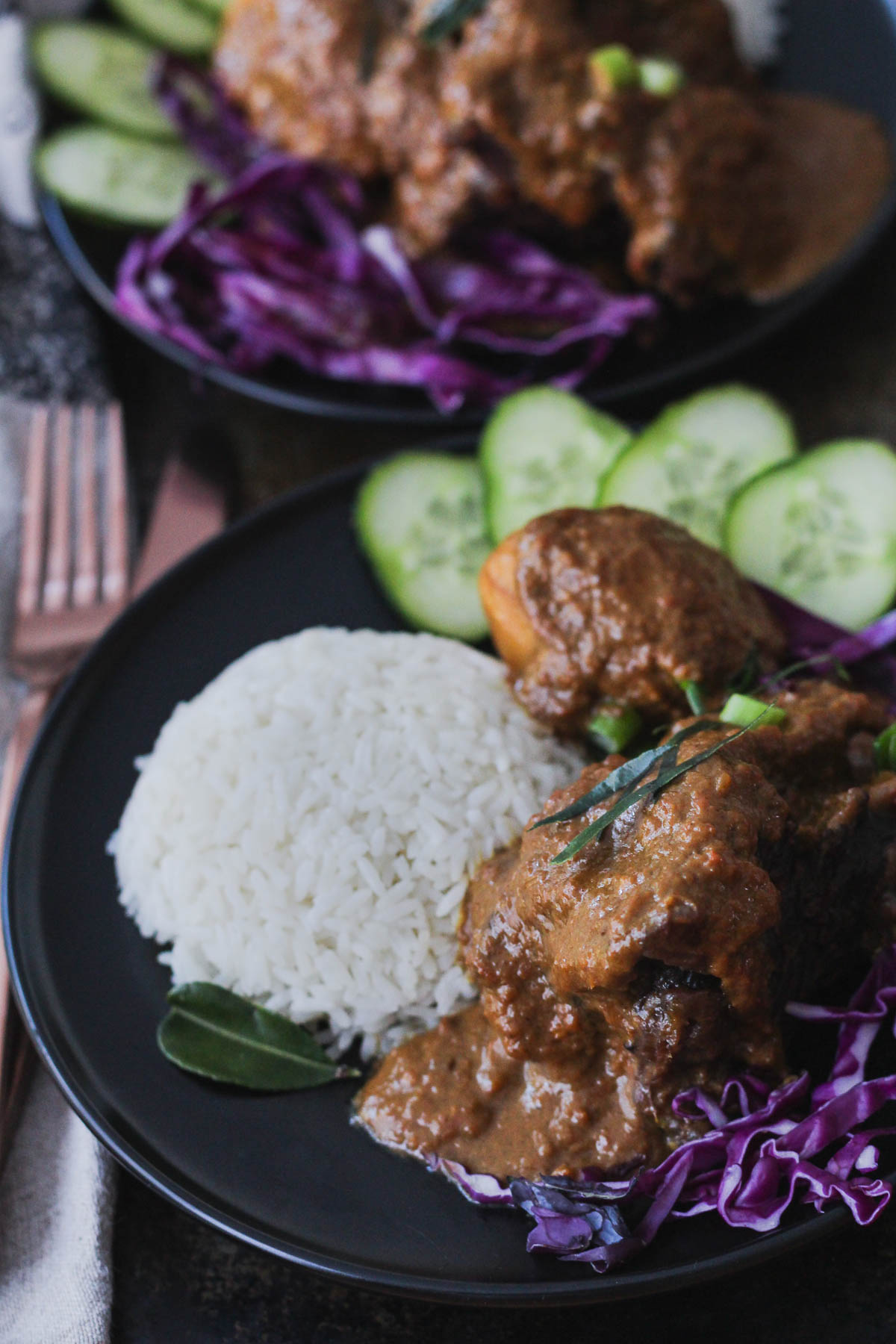No doubt, working on this recipe for Beef Cheek Rendang was one of the most enjoyable experiences in my kitchen.
I've decided that I'd very much like this dish to be my last, if I'm lucky enough to choose. The complex, delicious layers of flavour in Rendang curry are so unmistakable and moreish. Paired with the richness of beef cheeks, it's just perfect. I've provided options for different cooking methods, including pressure cooker/multicooker/Instant Pot, slow cooker or the oven.
History of Rendang
Of course, I can't take much credit for this recipe, since rendang curry has such a long history. Collectively, whomever was responsible for this dish should be very proud. The dish is originally from the Minangkabau people of West Sumatra, Indonesia and it later spread further afar in Indonesia and Malaysia. Rendang is believed to be approximately 500 years old.
My Rendang Rendition
This particular version here is an adaptation of two versions of Rendang from chefs I really admire - Neil Perry and Russ Crandall, of The Domestic Man blog. This Rendang recipe is how I like to make it. Not a strictly traditional version, but unforgettable all the same.
The paste recipe makes enough for 5 meals, so the leftover paste after it has first been made can be frozen for later use. That's something I always tend to forget when making a dish like this - I get annoyed at the long list of ingredients, but once I taste the dish and remember all the future meals to be made with the paste, I quickly forget all of that.
I like to use beef cheeks for rich recipes such as this and also my popular Korean Beef Cheeks recipe. In that post, I explain the health benefits of eating gelatinous cuts of meat and clear up the misconception that beef cheeks are overly fatty.
Rendang is known as a "dry curry", meaning the sauce is lovely and thick after being reduced. There is just enough sauce to coat the meat and potatoes. So keep that in mind as you're cooking, and you'll know what to expect.
How to cook beef cheeks
Beef cheeks are considered a tough cut of meat, and usually they take many hours to cook in an oven or a slow cooker. They're quite hard to cut in their raw state, so can be left whole. The quickest option to cook beef cheeks is using a pressure cooker/multicooker/Instant Pot. I know a lot of people might feel daunted cooking a new cut of meat, but cooking beef cheeks is really easy...you just need time! Below, I've explained the main cooking options for beef cheeks.
To cook beef cheeks using an oven or slow cooker, the exact steps depend on the specific recipe you're making. You may need to first use a frypan or a skillet on the stove to brown the meat or fry off some of the ingredients (eg. onions, garlic and/or paste). It really depends on the specific recipe and also whether you want to brown the meat or not. Browning meat can certainly add flavour but isn't always necessary - plus, it's quicker just to skip that step. For this Rendang recipe, the sauce does need to be fried off but the meat doesn't have to be browned. All ingredients are then added all together to the slow cooker or oven-safe dish.
Using these methods, the cooking can take anywhere from 3-8 hours, so ensure to take that time in to account. The oven is quicker than the slow cooker. Many recipes will require the sauce to be reduced afterwards, so keep that in mind too.
The best oven temperature is 160C/320F and the beef cheeks will take between 3 and 4 hours, depending on the size of the cheeks.
If using a slow cooker, I recommend using the high setting, as low just takes way too long - they should take between 6 and 8 hours depending on the size of the beef cheeks.
To cook beef cheeks in a pressure cooker/multicooker/Instant Pot, simply fry off/brown the base ingredients (eg. onions, garlic and/or paste) and/or brown the meat if that's what the recipe calls for. For some recipes, those steps aren't required, so always read the recipe instructions. After that, simply add all the ingredients to the bowl and cook according to the instructions in the recipe. The beauty of this method is how quick it is compared to using the oven or slow cooker - 90 minutes plus allowing time for the machine to come to pressure is sufficient.
How to make this recipe
For full instructions, see the recipe card below. The instructions below are primarily for the pressure cooker/multicooker/Instant Pot - the recipe card explains how to make this dish in the oven or slow cooker.
- Start off by making the paste in your food processor
- Prepare the other ingredients
- Add coconut oil to the heated pan and then add 145g of the paste to fry off (freeze remaining paste for future use)
- Add the remaining ingredients to the pressure cooker inner bowl, cook on high pressure for 80 minutes then use natural release for 10 minutes before opening the lid
- While the curry is cooking, prepare the rice, cucumbers, cabbage and lime leaves and set aside
- Remove the meat and potatoes, reduce the sauce for 10 minutes and then add them back in
- Serve with rice, cucumbers, cabbage and sliced lime leaves.
Are you on the Autoimmune Paleo Diet?
If you're on the AIP diet, replace the red bell pepper (capsicum) with 1 cup of mashed pumpkin and omit the red chillies. You can serve the rendang with cauliflower rice instead of regular rice.

Beef Cheek Rendang {Pressure Cooker, Slow Cooker or Oven options}
Equipment
- Your choice of: Electric multicooker/pressure cooker, stovetop pressure cooker, oven (using dutch oven) or slow cooker (crockpot)
- Food processor
- chopping board and knives
- Grater
- Measuring cups and knives
Ingredients
Rendang Paste
- 1 red capsicum (bell pepper)
- 5 small red chillies*
- 2 red onion
- 8 medium garlic cloves
- 3 teaspoons shrimp paste terasi - in a block or tub
- 2 stalks of lemongrass white part only
- 7 cm (3 inches) piece ginger peeled and grated
- 3 teaspoons ground Ceylon cinnamon
- 2 teaspoons powdered turmeric
- ½ teaspoon ground white pepper
- 1 teaspoon cooking salt
To make the Rendang
- 1 tablespoon of coconut oil
- 145g rendang paste (from above)
- 4-6 makrut lime leaves** (2 leaves for garnish)
- 4-6 teaspoons tamarind paste
- 2 tablespoons coconut sugar or brown sugar
- 2 tablespoons tamari sauce or gluten free soy sauce
- 250 mL (8 oz.) full fat coconut milk
- 1 kg (2 lb.) beef cheeks
- 6 medium potatoes peeled
- fine sea salt
To serve with Rendang
- sliced cucumber
- jasmine rice or cauliflower rice
- shredded red cabbage
- thinly sliced lime leaves
Instructions
Make the paste
- De-seed and dice the capsicum/bell pepper and chillies, peel and chop the onions and peel the garlic cloves.
- Blend all of the paste ingredients well in food processor. You will use ¼ of the paste for the recipe - the rest can be frozen in portions for each time you want to use it.
Make the curry and the rice
- Set the pressure cooker to saute or brown - either on the stove with a stovetop pressure cooker or using the saute/brown function on an electric pressure cooker/multicooker/Instant Pot.Take 145g (5 oz) of the paste, fry it off for 5 mins in the oil at medium heat.
- The remaining paste can be frozen in 145g (5 oz) amounts for future use.
- Trim the fat off the beef cheeks.
- Combine the coconut milk, tamari, brown sugar and tamarind paste in a bowl. Add this mixture and the remaining ingredients for the curry to the inner bowl of your pressure cooker. Cook for 70 minutes on high pressure - use the same amount of time for a stovetop pressure cooker.
- While the curry is cooking, prepare your jasmine rice according to packet instructions. You could also do this later, eg. when the pressure is releasing or the sauce is being reduced.
- Once the cooking time has finished, let the pressure release naturally for 15 minutes. Don't do a "quick release".
- Remove the potatoes and meat. Check the meat falls apart/is soft. If not, cut any large pieces and return to the pressure cooker for another 10 minutes, then remove and set aside.
Finalise the recipe
- The sauce will need to be reduced for approximately 10 minutes on high heat/saute function until thicker - the consistency to look for is a pourable but thick liquid. To minimise splatter, use a splatter guard or leave the lid slightly ajar.
- While the sauce is reducing, slice the cucumbers, shred the cabbage, and thinly slice the lime leaves.
- Add the meat and potatoes back in and season with salt if required.
- Serve with the above suggestions.
Notes
Hungry for more high quality recipes?
My second eBook, C’mon Gut Happy, is just what you need! Over 30 delicious plant based, gluten free recipes with evidence based ingredients to support your gut microbiome health!





Awesome restaurant quality meal!! I used The Spice Tailor- Indonesian Rendang pre made paste and Kara coconut cream watered down a little for my first attempt to make things a little easier. Also in a 6L 1000W pressure cooker on high I cooked beef cheeks without potatoes for 60 minutes then added potatoes cut into quarter chunks for a further 12 minutes as they usually disintegrate if cooked any longer. Probably will only add half to one tablespoon of tamarind paste next time as one and a half was a bit to strong for me but overall was a great dish : )
Glad you enjoyed the recipe!